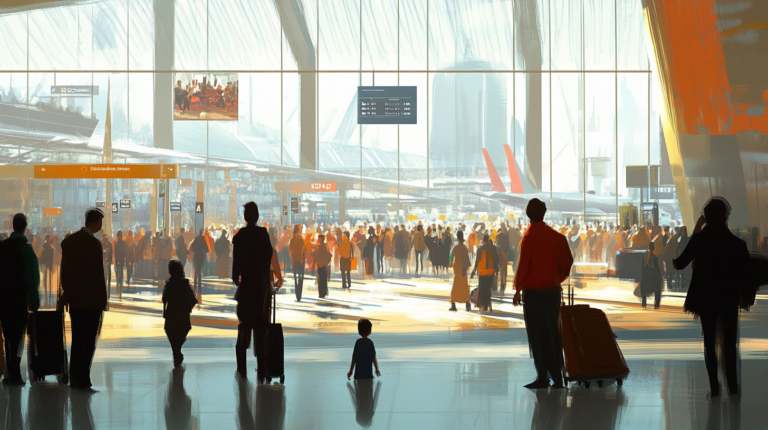SME Travel, Simplified for Frequent Flyers

In my travels across countless airports and flight routes, I’ve noticed small and medium-sized enterprises (SMEs) returning to business trips in record numbers. According to industry data from late 2024, global corporate travel bookings are up by nearly 10%, reflecting the growing confidence of organizations venturing back into the skies after a lengthy pause. Despite budget constraints, SMEs are finding modern travel management companies (TMCs) and advanced booking tools to be indispensable allies in navigating this new age of business travel.
Why SMEs Need Specialized Travel Solutions

I’ve seen firsthand how smaller organizations manage travel logistics without the same resources that large corporations take for granted. Many SMEs operate with limited personnel, so a clearly structured travel strategy can deliver significant savings. A well-designed policy sets the tone, empowering team members to comply with spending guidelines while enjoying a streamlined booking experience.
On one recent trip, I met an SME team that used 24/7 support offerings from a TMC to pivot their itinerary during weather delays. They ended up saving not only money on rebooked flights but also a great deal of hassle. These real-world experiences reinforce what a recent study by the Global Business Travel Association suggests: nearly 65% of smaller companies plan to rely more heavily on specialized online booking platforms by 2026 to cut costs and boost efficiency.
It’s also encouraging to see more women-led tech teams shaping the TMC landscape. From my perspective, this trend not only fuels innovation but also brings forward more inclusive solutions, proving that STEM diversity has tangible benefits for business travelers everywhere.
The Rise of TMCs and Online Booking Tools

Over the past few years, I’ve observed TMCs adopting data-driven insights to create better user experiences. According to industry reports, around 53% of SMEs in 2025 are leveraging AI-powered features—like predictive pricing models and automated expense reporting—to optimize travel costs. These tools allow managers to spot trends, address policy compliance issues early, and negotiate more favorable fares.
I’ve personally tested some of these emerging platforms, and I’m consistently impressed by how they handle the finer points of the booking process—such as recommended routes, cost comparisons, and real-time policy alerts. A recent example involved a mid-sized marketing agency that used a TMC’s AI assistant to track changing hotel rates in Asia. They ended up refining their budgets mid-trip, ensuring the team stayed under cost ceilings despite shifting travel dates.
Today’s TMCs also integrate seamlessly with collaboration tools, making it easy to share itineraries or expense sheets with colleagues. From what I’ve seen, the days of emailing spreadsheets back and forth are quickly becoming relics of the past. These modern solutions point to a future where augmented reality check-ins and instant rebookings could become standard fare for business travelers.
Top Picks for Seamless SME Travel

- Corporate Traveler’s Melon: Recognized for 24/7 assistance and robust policy enforcement, this platform has a free, 10-part SME Travel Toolkit. I’ve spoken with frequent flyers who praise its streamlined dashboard, which consolidates flight, hotel, and car rental info in one place.
- Lufthansa City Center: Offers a balanced mix of online ease and offline guidance, including 24/7 emergency services. During a recent delay in Europe, I saw them in action rerouting passengers with minimal disruption.
- myBiz: A self-service booking tool that secures special corporate rates and manages GST invoicing in real time. In conversations with small firms, they often highlight myBiz for its fuss-free reimbursement processes and dedicated support channels.
- TravelPerk, CTM, and Amex GBT: Featured in many 2025 roundups for their integrated expense-tracking platforms, AI-driven notifications, and custom travel policies. Their user interfaces are particularly friendly, making it easy for infrequent travelers to get up to speed.
Each of these solutions excels at automating paperwork and consolidating itineraries, so businesses can concentrate on meaningful goals instead of documenting every tiny detail. I’ve always found that time saved on admin tasks is time better spent fostering relationships and exploring new avenues for growth.
Making the Most of Travel Policies

An effective travel policy can save an SME thousands of dollars each year, especially when employees understand exactly how to adhere to guidelines. I’ve often recommended a basic checklist that includes booking lead times, preferred airlines, and maximum lodging rates. Not only does this approach clarify employee expectations, but it also encourages uniform booking practices that reduce rogue spending.
To create a policy that truly works, some SMEs are tapping into templates offered by platforms like Corporate Traveler’s SME Travel Toolkit. I’ve read through their case studies, and many success stories emphasize the importance of ongoing training. The best policies evolve with the landscape, accommodating new technologies and changing economic conditions. For instance, as remote work becomes more prevalent, policies must adapt to reflect employees who combine personal and work travel into a single trip.
Transparency is key: the more clear and upfront a policy is, the less likely employees are to bypass or misunderstand it. In my experience, distributing policy updates in accessible formats—like short mobile summaries—goes a long way toward ensuring compliance.
A Look Ahead

The future is bright, especially with new AI-driven solutions shaping how we plan and book corporate travel. Today’s TMCs already offer real-time rebooking for canceled flights, and I predict that by 2030, SMEs will also be taking advantage of augmented reality (AR) previews for airport navigation and mixed reality training sessions for employees traveling overseas.
During my discussions with industry insiders, I’ve heard talk of more advanced integrations—like AI-generated itineraries that incorporate fitness and wellness suggestions to help frequent flyers maintain a healthy lifestyle on the road. Research from a well-known bookings aggregator suggests that 82% of travelers are open to these personalized enhancements, reinforcing the notion that convenience and well-being go hand in hand.
I believe this trend extends well beyond software features. As we champion innovative solutions, we also champion the diverse teams building them. When more women join the ranks of those creating TMC platforms, we all benefit from a broader range of perspectives and ideas. It’s exciting to see technology, inclusivity, and traveler well-being converging to redefine how we explore the world.
Final Thoughts

SME travel management in 2025 is all about bridging the gap between budget sensitivity and top-quality experiences. With the right combination of specialized TMCs and intuitive booking tools, even smaller companies can embrace global business opportunities without losing track of costs or employee well-being.
From real-time reporting to pre-trip safety alerts, these solutions help keep everything humming along smoothly. I’ve witnessed the relief on a colleague’s face when a perfectly timed AI alert averted a missed flight connection. Moments like these remind me that the right technology is more than a convenience—it’s a vital partner for professionals on the move.
Amelia Yeaher’s Take
I’ve always loved focusing on the intersection of technology and travel innovation, especially given our near-future world that thrives on AI, AR, and experimental solutions. For me, seeing SMEs adapt to these trends—while also championing the contributions of women in STEM—is deeply rewarding, because it shows how diverse perspectives can power truly transformative results.
Flying is not just a tool for business; it’s a chance to explore, connect, and innovate. As SMEs continue to expand, I’m eager to see more creative, empathetic, and tech-savvy strategies that ensure everyone can enjoy a seamless journey.






